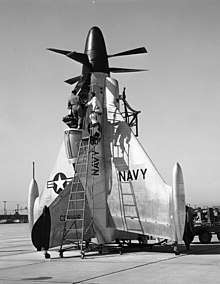Tail-sitter
A tail-sitter or tailsitter is a type of VTOL aircraft that takes off and lands on its tail, then tilts horizontally for forward flight.

Description
A tail-sitter sits vertically on its tail for takeoff and landing, then tilts the whole aircraft forward for horizontal flight. This is very different from the many other kinds of VTOL technologies, which have horizontally-oriented fuselages.
Tail-sitters change fuselage orientation after take-off. They start of with the back of the aircraft to the ground (...a vertical orientation), and then reorient to a horizontal orientation in flight.
Some tail-sitters then landed conventionally in horizontally-oriented configuration, while others had a much more ambitious goal of landing vertically with the aircraft's back to the ground, a highly hazardous procedure for many reasons, prime of which was increased fuel consumption and limited pilot visibility.
History
The concept of a tail-sitting aircraft was included in a patent by Nikola Tesla in 1928.[1]
The Focke-Wulf Triebflügel (wing-driven) fighter was a German tail-sitter project during the Second World War. Three wings were mounted radially as a rotor on a rotating section of the fuselage and driven by small jet engines on the wingtips. The aircraft was to be propelled by this wing rotation. For takeoff and landing it would fly vertically as a helicopter, then tilt over horizontally to fly as a self-propelled wing generating both lift and thrust. The contemporary Heinkel Lerche project had an annular wing forming a duct around a conventional propeller, and in the transition from vertical to forward flight the lift would have transferred to the wing. [2]
The SNECMA Coléoptère was a postwar French development of the annular wing concept, but powered by a turbojet. It flew in both vertical and horizontal flight modes but never achieved the transition between the two.
Meanwhile, the USA was experimenting with propeller-driven design configurations with relatively conventional fixed wings. The Convair XFY Pogo had a delta wing with cruciform tail and successfully demonstrated the full transition between flight modes, while the Lockheed XFV Salmon had a straight wing with X tail but never achieved the flight transition.
A later jet-powered design, the Ryan X-13 Vertijet, first flew in 1955. Two prototypes were made, both flew, made successful transitions to and from horizontal flight, and landed. The final test flight was near Washington DC in 1957.[3]
An inherent problem with all these tail-sitter designs was poor pilot visibility, especially of the ground, during vertical descent and landing. This led to the concept being abandoned once a more practical form of VTOL appeared, in the form of thrust vectoring.
An UAV does not suffer the problem of pilot attitude. The Dornier Aerodyne is of ducted-fan configuration similar to a coleopter, and a test UAV flew successfully in hover mode in 1972, before development was discontinued.
Studies and wind tunnel models were made of a tail-sitting version of the F-16 that would be ship based, but any further development was abandoned due to the large thrust requirement, and the need for extensive apparatus to handle take-off and landing.[4]
List of tail-sitters
| Type | Country | Date | Role | Status | Description |
|---|---|---|---|---|---|
| AeroVironment SkyTote | USA | 2010 | UAV | Prototype | None |
| Bachem Ba 349 | Germany | 1944 | Interceptor | Prototype | Launched up a vertical tower, landed using parachutes. |
| Bell Apt | USA | 2019 | UAV | Prototype | Planned for delivering[5] |
| Bolköw P 110.1 | West Germany | 1950s | VTOL Fighter | Project | None [6] |
| Sukhoi Shkval | USSR | 1960 | Interceptor | Development ceased,partial Mockup | equipped with a conventional Landing gear.side-by-side afterburner engines. |
| CDADI VD200 | China | 2014 | UAV | Project | None |
| Convair XFY-1 Pogo | USA | 1954 | Fighter | Prototype | None |
| Dornier Aerodyne | Germany | 1972 | UAV | Prototype | None |
| Focke-Wulf Triebflügel | Germany | 1944 | Interceptor | Project | Rotor wing around middle of fuselage. In-flight transition never resolved. |
| Focke Wulf Fw 860 | West Germany | 1950s | VTOL Fighter | Project | None [7] |
| Heinkel Lerche | Germany | 1944 | Fighter | Project | None |
| Heinkel He 231 | West Germany | 1950s | VTOL Fighter | Project | None |
| Lockheed Martin Cormorant | USA | 2008 | UAV | Prototype | None |
| Lockheed XFV-1 | USA | 1954 | Fighter | Prototype | None |
| Messerschmitt Me X1-21 | West Germany | 1950s | VTOL Fighter | Project | None [8] |
| NASA Puffin | USA | 2010 | Private | Project | None [9] |
| Northrop Grumman Tern | USA | 2018 | UCAV | Prototype | None |
| NSRDC BQM-108 | USA | 1976 | UAV | None | None |
| Rotary Rocket Roton ATV | USA | 1999 | Experimental | Prototype | Rotorcraft test vehicle for proposed SSO space launcher. |
| Ryan X-13 Vertijet | USA | 1955 | Experimental | Prototype | None |
| SNECMA Coléoptère | France | 1959 | Experimental | Prototype | Never achieved transition. |
See also
| Look up tailsitter in Wiktionary, the free dictionary. |
References
- "Nikola Tesla U.S. Patent 1,655,114 - Apparatus for Aerial Transportation". 2015-03-01. Retrieved 2016-08-07., Tesla Universe.
- Dan Sharp, Luftwaffe: Secret Weapons of the Third Reich, Mortons, 2015
- Darling, Jeff (2011-06-13). "Ryan X-13 Vertijet". Diseno. Archived from the original on 2014-01-28. Retrieved 2014-02-09.
- Newsom, William A.; Anglin, Ernie L. (September 1975). "FREE-FLIGHT MODEL INVESTIGATION OF A VERTICAL-ATTITUDE VTOL FIGHTER" (PDF). National Aeronautics and Space Administration. Retrieved October 16, 2016.
- "Bell APT". Bell Flight. Retrieved 2019-10-14.
- http://www.robertcmason.com/textdocs/GermanVSTOLFighters.pdf
- http://www.robertcmason.com/textdocs/GermanVSTOLFighters.pdf
- http://www.robertcmason.com/textdocs/GermanVSTOLFighters.pdf
- Choi, Charles Q. (2010-01-19). "Electric Icarus: NASA Designs a One-Man Stealth Plane". Scientific American. Retrieved 2010-02-27.